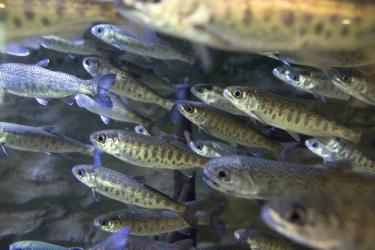On June 19th, NWFSC Environmental Conservation Division Director Dr. Tracy Collier gave testimony before the Committee on Natural Resources in the U.S. House of Representatives, addressing the adverse effects of endocrine disrupting chemicals (EDCs) on the endocrine systems of fish and wildlife.
The endocrine system is a network of glands, hormones and receptors that transmit chemical messages regulating the development and growth of nervous and reproductive systems in mammals, birds, and fish. Endocrine disrupting chemicals block or mimic these naturally-occurring chemicals, with potentially devastating effects on reproduction and growth.
Man-made industrial chemicals, including flame retardants (PBDEs), plasticizers, and surfactants, along with some fungicides and herbicides, find their way into fish habitats through surface runoff. According to Dr. Collier’s testimony, “surveys by USGS, NOAA, and other agencies indicate that EDCs are most prevalent in industrialized, agricultural, and/or urbanized areas, with particularly high concentrations of these compounds near sewage treatment plants, or other sources of wastewater, feedlots, pulp and paper mills, and in urban and industrial areas with high levels of organic chemical contamination.”
Legacy contaminants
Legacy contaminants like PCB and DDT were banned in the 1970s and, although “no longer being actively introduced into the environment they are often still present at levels that can impair fish growth, reproduction, and immune function.” Fish found in PCB-contaminated waters “show various forms of reproductive dysfunction, including depressed levels of reproductive steroids, reduced gonadal growth, and reduced egg and larval viability. These effects have been documented in fish from Puget Sound, San Francisco Bay, Los Angeles, Hudson Bay, Chesapeake Bay, and other coastal habitats.”
Pharmaceuticals
Synthetic hormones, pharmaceuticals, and personal care products can mimic the actions of estrogen. “Estrogenic chemicals have been linked to a variety of other physiological and developmental abnormalities in fish, including reduced male fertility, reduced embryo viability, impaired seawater tolerance (migratory salmon), altered social behaviors, and disrupted courtship behavior.”
Marine Mammals
Since many marine mammals are at the top of the food chain and long-lived, they can accumulate high levels of contaminants. Research on California sea lions found that females “that produce stillborn pups and aborted fetuses have significantly higher levels of PCBs and DDTs in their blubber relative to females that produce normal pups. Similar to fish, legacy contaminant exposure is associated with immune suppression in marine mammals.”
Removing EDCs from the environment
Techniques for reducing EDC concentrations in wastewater are under development and the Environmental Protection Agency (EPA) is addressing the environmental impact of pharmaceutical and personal care products. “However, the persistence of some of these chemicals in the food chain and their introduction into pristine environments due to long-range transport suggests it may be impossible to completely eliminate them from our ecosystems.”
Many gaps remain in our understanding of EDCs and endocrine disruption in marine life. Low levels of dissolved oxygen and temperature can also affect endocrine function, making it difficult to establish a simple cause and effect relationship.
”[W]e should not rely only on reductions in EDCs in effluents in order to protect our living resources. Rather, we need to continue to investigate the linkages between exposure to EDCs and biological impacts, and to monitor and assess these linkages in the real world, not just in laboratory settings.”


